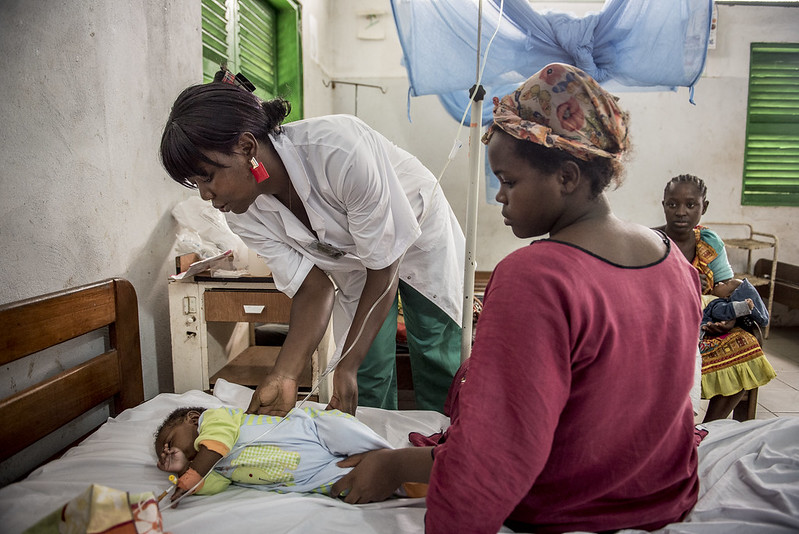
Public health leaders have slowly begun to understand the role of gender in the use of health services, including services for malaria prevention and treatment. Unequal power dynamics within couples and women’s lack of control of financial resources and increased household responsibilities all impact their ability to seek services for themselves and their children.
This we know. But what we are still learning is how gender impacts providers-not just the quality of care they provide, but their own ability to advance professionally. A recent secondary analysis of malaria provider training data conducted by Jhpiego as part of the PMI Impact Malaria project sought to answer this question. We looked at over 23,000 data points across 11 countries to understand what was happening and validated our results with PMI Impact Malaria country teams to understand why we saw the results that we did.
First, we found that for most training topics for most countries, training participants were more likely to be men. Sometimes this reflects the actual gender breakdown of providers in the cadres targeted for trainings. For example, in Ghana, Cote d’Ivoire, Mali, and Cameroon, malaria case management trainings targeted doctors and pharmacists, who are more likely to be men, as they were encouraged to go into sciences while women were encouraged to go into caring fields like nursing and midwifery. The biggest disparity was in lab diagnostics, with up to 95% of participants being men. This was not only due to social expectations sending men into sciences and women into caring fields, but also due to the demands of the job. The team in Mali noted that once a lab technician received her degree, she could be sent anywhere in the country, and many women felt unable to make this move when their husbands already had jobs in their hometowns.
Even in cases where the cadre was mostly women, training participants were mostly men. In Cameroon and Cote d’Ivoire, teams noted that while nurses—the cadre targeted for malaria in pregnancy trainings—were mostly women, the managers, who selected the training participants, were mostly men, and they were more likely to select other men to participate in the trainings.
Women’s lack of participation in trainings also impacts their performance when they are able to participate. We found that women perform better when trainings have equal numbers of women and men, or more women; country teams suggested that this was because it helped women feel more comfortable in the training environment so they could more easily participate and ask questions.
Teams also noted that women made fewer gains and performed worse overall during training due to household and childcare responsibilities (such as bringing infants to trainings or leaving early to complete household tasks); having less experience in the field than male counterparts—which caused challenges due to knowledge gaps and as well as power differentials between senior men and junior women in the same room; and having only male instructors who are not aware of these gendered challenges.
Why does this matter? When woman are not selected for professional development opportunities, or are seen to be less likely to succeed in these opportunities when they are chosen, they lose out on the chance to gain new skills and make new professional connections, which impacts their ability to advance in their field. This not only impacts their income levels, but makes it harder for them to become the decision-makers who can then choose to support other women’s advancement.
So what can we do about it? When our team in Mali became aware of the gender imbalance among participants, they began to encourage managers to make a more balanced selection, and female training participation increased by almost 40%. When our team in Ghana found midwives were having a hard time attending full day trainings because they had to leave early to be home when their children arrived from school, they changed their training plan to multiple half day trainings. When they found that many women providers traveled to attend trainings with infants and nannies, the team ensured that their catering plan and budget included food for these extra attendees and provided regular breaks to allow participants to breastfeed. These seemingly minor adaptations resulted in increased participation of female providers and greater opportunities for professional advancement.
Elizabeth Arlotti-Parish is a Principle Technical Advisor for Gender in Jhpiego’s Baltimore office.
Dr. Gladys Tetteh, Jhpiego’s Senior Technical Director for Malaria, provided technical review of this article.
5 Actions to Support Women Health Workers’ Advancement
- Revise job descriptions to remove barriers to women’s recruitment in cadres targeted for trainings
- Orient decision-makers on participation disparities, to encourage gender equitable selection of training participants
- Modify training schedules to meet women health workers’ time and responsibility constraints;
- Budget for child care, meal and lodging for child care workers, and time and space for breastfeeding breaks at trainings
- Hire more female instructors and orient all instructors on barriers faced by participants of different genders




